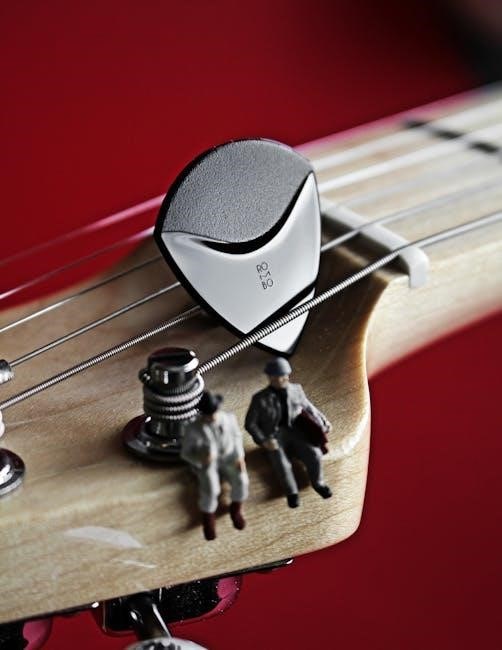Learning guitar scales is essential for musical development, providing a framework for understanding intervals and building skills. Start with major, minor, and pentatonic scales for versatility in various styles.
1.1 Why Guitar Scales Are Important for Beginners
Guitar scales are crucial for understanding music theory, intervals, and note relationships. They provide the foundation for creating solos, improvising, and learning songs. Scales also enhance technical skills like finger strength and dexterity, allowing for smoother transitions across the fretboard. Mastery of scales opens up various musical styles, making them essential for every beginner’s journey toward becoming a versatile guitarist.
1.2 Understanding the Basics of Musical Scales
Musical scales are sequences of notes arranged in a specific pattern of whole and half steps. They form the backbone of music, providing structure for melodies and harmonies. Major and minor scales are the most common, with major scales offering a happy, uplifting sound and minor scales a sadder, more introspective tone. Understanding scales helps in recognizing patterns on the fretboard, making learning and playing guitar more intuitive and enjoyable for beginners.
The Major Scale: A Foundation for Beginners
The major scale is a cornerstone for guitarists, offering a bright, uplifting sound. It serves as the basis for many other scales and musical compositions, making it essential to master early on for building foundational skills and versatility in playing various styles.
2.1 What Is the Major Scale?
The major scale is a fundamental musical concept consisting of seven notes arranged in a specific whole and half-step pattern: W-W-H-W-W-W-H. This sequence creates a bright, uplifting sound. It is the foundation for many other scales and modes, making it essential for beginners to understand and master. Learning the major scale helps develop finger strength, improves understanding of intervals, and enhances the ability to play melodies and solos across various genres.
2.2 How to Play the C Major Scale on Guitar
The C Major Scale is a versatile scale that can be played in multiple positions on the guitar. Start by placing your finger on the 3rd fret of the A string (C note). The sequence of notes is C, D, E, F, G, A, B, and back to C. Each note is one fret apart, except between E-F and B-C, which are half-steps. Use your index finger for the 3rd fret (C) and middle finger for the 4th fret (D). Continue with your ring and pinky fingers for the higher notes. Practice playing each note clearly, focusing on proper fingering and string placement. This scale is a great starting point for beginners, as it helps build finger strength and improves technique. By mastering the C Major Scale, you’ll lay a solid foundation for learning other scales and melodies.
2.3 Tips for Memorizing the Major Scale
Memorizing the major scale becomes easier with consistent practice. Start by breaking the scale into smaller sections and gradually combine them. Use a metronome to improve timing and focus on playing cleanly. Practice scales in different positions to build familiarity with the fretboard. Associating notes with simple melodies or songs can also aid retention. Lastly, visualize the scale patterns while playing to reinforce muscle memory and theory understanding.

Minor Scales: A Guide for Beginners
Minor scales add emotional depth to your playing. They are fundamental for creating soulful melodies and understanding music theory; Start with the A minor scale, a great introduction to minor tonalities.
The minor scale provides a somber and introspective sound compared to major scales. It consists of seven notes with specific whole and half-step intervals. For beginners, starting with the A minor scale is ideal due to its straightforward fingering on the guitar. Understanding minor scales enhances your ability to play melodies and solos with emotional depth. Practice regularly to master this essential scale.
3.2 How to Play the A Minor Scale on Guitar
The A minor scale is a popular choice for beginners. Start by placing your first finger on the first fret of the B string. Play the open A string, then the second fret of the D string, and the second fret of the G string. Continue with the open B string, third fret of the high E string, and second fret of the B string. End on the open A string. This pattern covers the A minor scale in a straightforward manner.
3.3 Understanding the Difference Between Major and Minor Scales
Major scales often evoke a bright, happy sound, while minor scales are associated with a sadder, more introspective tone. The key difference lies in their intervals; major scales follow a whole-whole-half-whole-whole-whole-half pattern, whereas minor scales use whole-half-whole-whole-half-whole-whole. This variation in intervals creates distinct emotional qualities. For beginners, understanding this distinction helps in choosing the right scale for their musical expression and enhances their ability to convey emotion through playing.
Pentatonic Scales: Simplified for Beginners
Pentatonic scales are simple, versatile patterns with five notes, ideal for beginners. They are widely used in rock, blues, and jazz, offering a foundational framework for solos and improvisation.
4.1 What Are Pentatonic Scales?
Pentatonic scales are five-note musical patterns used across various genres like rock, blues, and jazz. They are simpler than major or minor scales, making them accessible for beginners. These scales provide a versatile foundation for solos and improvisation, allowing guitarists to create melodies with minimal complexity. Their structure offers a straightforward approach to understanding music theory while enabling expressive playing from the start.
4.2 How to Play the Minor Pentatonic Scale
The minor pentatonic scale is a versatile five-note pattern ideal for beginners. Start by identifying the root note, then play the next four notes following the interval pattern. For example, the A minor pentatonic scale includes the notes A, C, D, E, and G. Use open strings or simple finger positions to play these notes in sequence. This scale is commonly used in rock and blues, making it a great starting point for solos and improvisation. Practice slowly to build familiarity and confidence.
4.3 Using the Major Pentatonic Scale in Solos
The major pentatonic scale offers a bright, uplifting sound, making it perfect for crafting memorable solos. Start by identifying the root note and play the scale in sequence. This scale is widely used in rock, pop, and country music. To add variety, experiment with bending strings or adding chromatic passing tones. Practice soloing over chord progressions to develop a natural, flowing sound. Over time, this scale will become a go-to for creating inspired, melodic solos.

Essential Guitar Scales for Beginners
Mastering the E minor, G major, and blues scales is fundamental for beginners. These versatile scales are easy to learn and widely used in various musical styles.
5.1 The E Minor Scale: A Beginner’s Favorite
The E minor scale is a popular choice for beginners due to its simplicity and versatility. It is commonly used in various music genres, including rock and blues, making it a great starting point. The scale’s open position pattern makes it easy to play without complex finger stretching. Learning the E minor scale enhances your ability to play solos and improvisations effectively. It is highly recommended for those new to guitar scales.
5.2 The G Major Scale: Open Position Patterns
The G major scale is a fundamental scale for beginners, offering a clear introduction to open position patterns. It is widely used in various musical styles, making it a versatile choice. The scale’s structure allows for easy finger placement without requiring complex stretches. Practicing the G major scale in open positions helps build finger strength and dexterity while familiarizing you with the fretboard layout, which is essential for further scale exploration and musical improvisation.
5.3 The Blues Scale: Adding Flavor to Your Solos
The Blues Scale is a 5-note scale that adds emotional depth and flavor to solos. It’s a variation of the Minor Pentatonic Scale with an added “blue” note, creating tension and release. Ideal for beginners, it’s simple to learn and versatile, fitting into rock, jazz, and blues music. Start with the E Blues Scale, as its pattern is visually straightforward on the fretboard. Practice it slowly and experiment with phrasing to enhance your solos.
How to Practice Guitar Scales Effectively
Set a daily routine, use a metronome to improve timing, and practice scales in different positions to build familiarity and mastery across the fretboard.
6.1 Setting Up a Daily Practice Routine
Dedicate 15-30 minutes daily to scale practice. Start with warm-ups, then focus on technique and accuracy. Break practice into segments: 5 minutes on warm-ups, 10 on scales, and 5 on applying scales to songs. Use a metronome to improve timing and gradually increase speed. Track progress weekly and adjust your routine as skills improve. Consistency is key to mastering guitar scales effectively.
6.2 Using Metronomes to Improve Timing
A metronome helps develop precise timing by providing a steady tempo. Start with a slow setting to focus on accuracy, then gradually increase the speed. Practice scales along with the metronome to build rhythm and consistency. This tool enhances your ability to play in time, essential for smooth scale execution. Regular use improves timing and coordination, allowing you to perform scales confidently and accurately during practice and performance.
6.3 Practicing Scales in Different Positions
Practicing scales across the fretboard enhances versatility and understanding. Start by learning scales in open positions, then gradually move to higher frets. This approach builds finger strength and familiarity with the fretboard. By exploring different positions, you’ll master various scale shapes and improve your ability to play seamlessly across the guitar. Regular practice in multiple positions also expands your musical range and prepares you for more complex techniques and improvisation.

Free Printable Guitar Scales PDF Resources
Discover essential scales with free downloadable PDFs. These resources offer clear diagrams, tabs, and patterns for major, minor, pentatonic, and blues scales, perfect for beginners to practice and master.
7.1 Best Websites for Downloading Guitar Scale PDFs
Several websites offer high-quality, free guitar scale PDFs for beginners. myguitarpal.com provides detailed scale diagrams and patterns. Guitar Mastery Method offers printable PDFs for major, minor, and pentatonic scales. Additionally, resources like TrueFire and GuitarLessons365 include downloadable PDF charts. These websites are ideal for beginners, offering clear tabs, fretboard diagrams, and step-by-step guides to help you master essential scales efficiently.
7.2 How to Use Printable Scales for Practice
Printable guitar scales are invaluable for structured practice. Start by focusing on one scale at a time, using the PDFs to guide finger placement. Practice scales slowly with a metronome to improve timing. Gradually increase speed as confidence grows. Use the diagrams to explore scales in different positions on the fretboard. Combine scales with chord progressions to apply them musically. Regular review of printable scales helps reinforce muscle memory and theoretical understanding, making practice more effective and enjoyable.

Additional Tips for Mastering Guitar Scales
Consistently practice scales to build finger strength and improve technique. Start slow, focus on accuracy, and gradually increase speed. Use metronomes for better timing and explore scales in different positions to enhance versatility. Break scales into smaller sections for easier learning and apply them to real songs to reinforce their practical use. Stay patient and persistent, as mastery takes time and dedication.
8.1 Understanding the Fretboard Layout
Mastering the fretboard layout is crucial for navigating scales effectively. Learn the note names, octaves, and string layout to visualize patterns. Familiarize yourself with how scales repeat across the fretboard. Use tools like fretboard diagrams or apps to aid memorization. Understanding note relationships and intervals will enhance your ability to play scales fluently. Recognize recurring patterns in scales to simplify learning. This knowledge will help you transition between scales and explore improvisation confidently.
8.2 Learning Scale Patterns Step by Step
Begin by breaking scales into smaller, manageable sections. Focus on one position or shape at a time, gradually expanding your range. Practice connecting patterns across the fretboard to build fluidity. Use tablature and diagrams from PDF resources to guide your learning. Start with slower tempos and increase speed as confidence grows. Repetition and consistency are key to memorizing and mastering scale patterns effectively for both major and minor scales.
8.3 Applying Scales in Real-World Playing
Apply scales by improvising over simple chord progressions, starting with familiar songs. Use the minor pentatonic scale for blues and rock solos, and major scales for brighter, uplifting melodies. Experiment with different genres to understand how scales fit into various musical contexts. Printable PDFs can provide exercises and etudes to help integrate scales into your playing. This practical approach makes learning scales fun and rewarding, enhancing your ability to create meaningful music.
Advanced Scales for Beginners to Explore
Explore harmonic and melodic minor scales for richer sounds. These scales add complexity and emotion to solos, while pentatonic variations keep things simple yet effective.
The harmonic minor scale offers a rich, exotic sound, making it perfect for adding emotional depth to solos. It’s formed by raising the 7th note of the natural minor scale. For beginners, starting with the E harmonic minor scale is ideal, as it’s easy to play in the open position. This scale is versatile and can be used in various musical genres, from rock to jazz. Mastering it will enhance your improvisational skills and expand your musical expression.
9.2 Exploring the Melodic Minor Scale
The melodic minor scale is a versatile scale used in jazz and classical music. It differs from the natural minor by raising the 6th and 7th notes when ascending. For beginners, learning the A melodic minor scale on the guitar can be a great starting point. This scale offers a bright, uplifting sound and is highly effective in solos. Practicing it in different positions will help build finger strength and improve your overall technique, making it a valuable addition to your skill set.
9.3 How to Use Scales in Improvisation
Mastering scales is key to confident improvisation. Start by practicing scales over simple chord progressions, focusing on how each note interacts with the chords. Experiment with blending major and minor scales to create emotional depth. Use the pentatonic scale for a more straightforward, bluesy feel. As you gain comfort, incorporate melodic minor scales for a brighter, jazz-inspired sound. Always listen to how your notes flow and connect, aiming to tell a musical story through your playing.
